Testing - Output Valves
Testing main | Testing Pre Amp Valves | Testing Output ValvesBurn in Process –The Watford Valves way.
The valves characteristics change quite dramatically during the first hours of use. It is also in these early stages that 95 % of output valve failure occurs. There are many reasons for this such as too much residual gas from inside the envelope left from imperfect manufacturing vacuum, Instability due to non-existent factory ageing or impurities in the coating of the valves anode plates which can cause red plating. These are just some of the common faults that we have found. At this point it is clear to anyone that uses valve amplifiers that they need to have been put through a thorough selection process first. The most important process is the burn process as it is by this process that most valve problems can be detected.
Many valve suppliers use low voltage burn in rigs and claim long burn in times. When you look at the equipment they use and see that they run the valves with an anode voltage of 65 volts, then they may as well claim a month of Sundays as this will not stabilise the valves. Whilst this system is better than none at all, it really is an inadequate way to check what a valve will actually do when it is installed in your amplifier.
At Watford valves power output valves are first mounted in our own custom designed burn in rigs.
The valves are run in these rigs for 24 hours and as these rigs run the valves in real working conditions in real working amplifiers, the valve will experience exactly what it will meet when installed in your amplifier. These rigs run the valves both statically and dynamically to ensure that all valves undergo exacting quality control measures. Under these conditions we find valves that Arc, short circuit, red plate or go into thermal runaway.
It is at this stage also we subject our own Harma Brand and valves that have our super premium designation to the additional Drive Testing/Burst testing regime. Here the valve undergoes a series of timed and controlled bursts. The stress that the valve is put through is exactly the same as it will encounter in your amplifier when you hit a hard power chord or drive you amplifier hard.
By running valves in working conditions we can correctly age and stabilize the valves to prevent drift on both current draw and gm, this is vital for close matching and critical for great tone. We can eliminate valves which will red plate with correct bias, plate and screen voltages applied, this is something that low voltage burn in will not identify. This process we do both dynamically and statically to further assure reliability.
Guitarist magazine stated “Watford valves, with the aid of its custom built test rigs, puts the valves under real working conditions which is equivalent of a hellish week with the US navy seals."
Only after a valve successfully passes these exacting tests it is then matched on Anode current (mA) and Transconductance/gain (gm) and placed into stock and offered for sale.
Manufactures whose product have a consistently high reject rate or provide inconsistence batches with valves not meeting these criteria are rejected and items from these manufactures are not stocked.
Output Valve Matching- The Watford Valves way
We offer free matching on standard output valve types such as 5881, 6550, 7027A, 7591A, 6L6GC, 6V6GT, EL34, EL84, KT66, KT77 & KT88 only or unless stated in our valve description. All other output valves can be matched so please enquire as a quotation can be provided for you particular valve type.
Standard Matching
Standard matching is done after the burn in process via our digital valve test rig with all valves being dual matched on anode current (plate current) and g/M (Transconductance) in real working conditions. Many companies simply match on anode current. This will not result in a good match as it is not an indication of the valves ability to amplify the signal. The transconductance or gain as it is sometimes referred to is the measure of when a valve will clip. So we believe that both measurements are vital to ensure optimum performance or selection. This also enables us to supply valves of the same brand with different characteristics to suit your requirements.
Our rig is one of the most accurate available today as it can match valves to 1 % accuracy on both parameters. All matching and testing is done with fully regulated supply voltage at 240v.
All valves are selected in real working conditions and selected to provide the strongest, most reliable valves for today's professional music hire and touring musicians.
Drive testing/ burst testing AKA super premium testing
Drive testing/burst testing is standard on all Harma output valves and is sometimes offered on other makers of valves. When we offer bust testing on the valves other than the Harma brand then it will listed on our website and called super premium and listed in the valve option box.
What is super premium burst testing? and how is Harma valves test procedure different?
During the controlled burn in process and each valve is subjected to a series of time signal bursts.
These bursts are designed to replicate the stress and punishment the valve sees when being used in your amplifier. This system was first developed to test the valves in Brian Mays Vox amplifiers when Brian was doing his first solo tour in 1997. The System had to recreate all the stresses on the valve that it would encounter in Brian’s amp on a World tour from a single note to a sledgehammer power chord. To do this the valve is exposed to a controlled series of programmed small signal bursts right though to full on drive. We had to basically reproduce everything that Brian could throw at his valves in The Vox amplifier in a real life working situation.
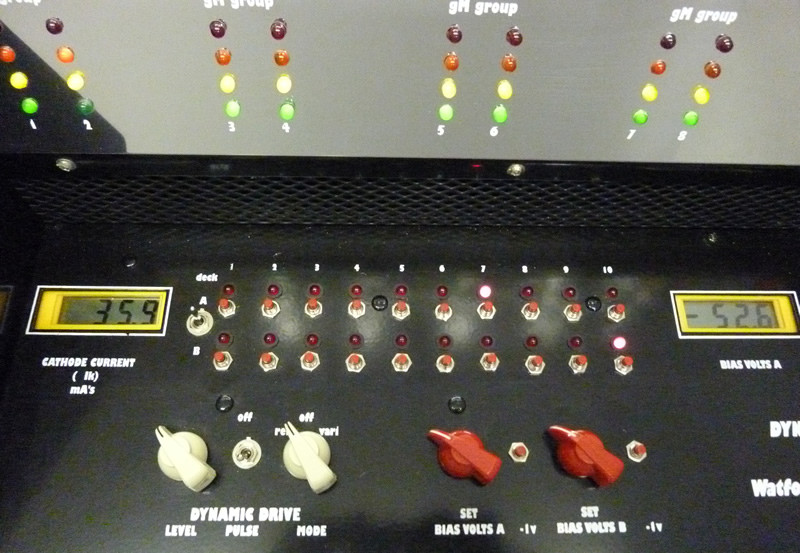
This system was so successful that we then embarked on the same system for testing octal power valves. In this system we also developed a unique traffic like system which at any given bias voltage or drive voltage shows when the valve will clip. This is done in real working conditions and so will provide exactly the same performance in your amplifier. This allows the closest dynamic matching
Available and is unique to Watford valves.
Only when a valve passes all these tests that it gets the Harma brand.
Hence all Harma valves are tested this way and when other maker’s valves are tested this way they will have the burst tested super premium designation in the product description.
Valves that are tested in this way are often only slightly more expensive than the same types offered by other valve resellers. They therefore offer outstanding valve for money and peace of mind. Unfortunately many of these companies do not have the technical or financial ability to conduct exacting quality-control measures. Many of these companies use systems that only do part of the job, they test output valves at low voltage simply to get more valves to pass. Some use timed relays in their test system and give computer printed labels, alas these system only put the valve full under load for a matter of seconds or a best minutes. The result is valves that have not faced the conditions that they will meet in your amplifier, which in turn leads to premature failure. So that is why we developed the Drive/Burst testing system, because in Brain case normal testing was simply not good enough.
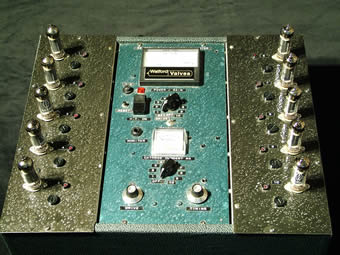
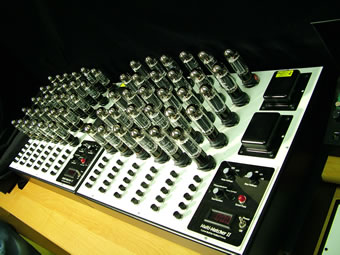
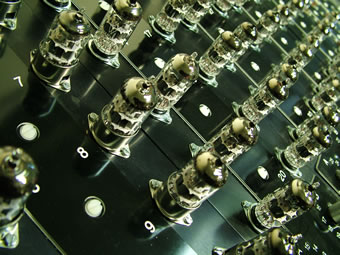
Warranty- No Quibble satisfaction guaranteed!
The Company warrants that the goods are of satisfactory quality on the following basis. All valves for a period of 3 months from date of invoice, Harma Diamond valves have 6 months, Except for the following valve types 211, 274b, 6146, 2a3, 6b4g, px4, and px25 and Sweep valves such as EL509/519, PL509/519 for 14 days from date of invoice. Mercury filled Rectifier valves such as type 83 and 845 triodes valve have 30 days from date of invoice.
This warranty is subject to the valves being fitted by a qualified technician and the amplifier bias being checked, monitored and adjusted. Valves must be operated within the stated manufactures limits for the valve type. Valves that are operated outside their rated limits, installed in modified equipment contrary to manufactures original specification or incorrectly installed will invalidated any warranty or return.Warranty and rebiasing you amplifier
This section is designed to give you some practical advice on what you should do when replacing output valves. This is especially relevant if you have had a valve failure or a fuse blow.
All the valve suppliers and resellers and manufactures the world over require for their warranties to be valid that when replacing output valves it is essential that the bias voltage is checked on installation and set by a qualified technician.
This includes amplifiers with fixed/self-bias and amplifiers with user adjustable bias indication lights. Output valves cannot be changed without correct monitoring of the valve and the related circuitry and components to ensure correct operation.
The common misconception is that a fixed bias amp does not require bias adjustment.
A fixed bias amp works with a negative voltage supplied to the grids of each output valve with the cathodes grounded. This results in the grids being negative with respect to the cathode. As the negative voltage supplied to the grid is a “fixed voltage” the amp is called a fixed bias circuit. This does not mean that the bias is not adjustable, far from it. If the amplifier is running to hot then the bias need to be adjusted to make the valves run cooler.
Some fixed biased amplifiers have a bias trim pot which will allows for minor adjustments to be made to the negative voltage applied to the grids of the valves. If this does not supply enough voltage swing or in the case of many vintage amplifiers does not have an adjustable pot. The technician would normally adjust the bias by changing the resistor valve in the negative voltage supply. The more negative voltage applied to the control grids of the valves the cooler the amp will run. The Less negative grid bias applied the hotter the amplifier will run.
This adjust is vital to ensure not only the correct running of your amplifier but more importantly is required in order to get the best sound. If this is not done then the short answer is it can cause problems which are why we and all other valve suppliers and manufactures recommend that this is done when changing output valves. So by having a receipt from a known qualified company or technician if by chance you run into a problem then we can resolve the problem quickly,
So by doing the right thing you not only get a great sound you get complete peace of mind.
We cannot accept liability for valves which are operated outside the manufacturer’s operational limits, breakages, valve failure due to incorrect bias voltage or component failure. We are not liable for any consequential loss or damage to individual or equipment. Guitar amplifiers contain lethal voltages which can cause personal injury or death. Do not attempt to carry out any modification or adjustments yourself. Always refer your amplifier to a qualified technician. All valves are fitted at your own risk.
For more in formation
See our Biased Information article in
February 2001 p139
Article by Derek Rocco
Biased Information
 Valves
Valves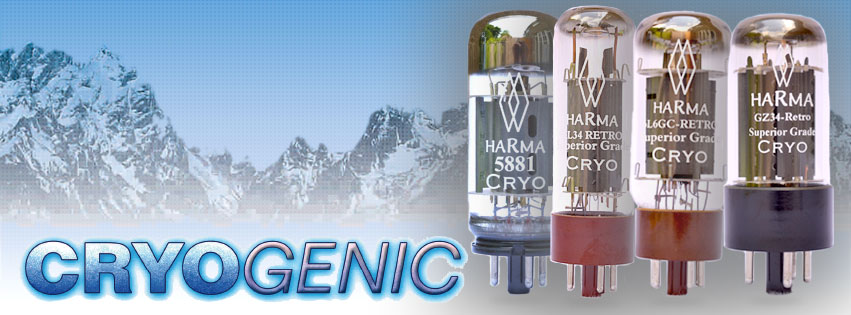 Cryo Valves
Cryo Valves Kits
Kits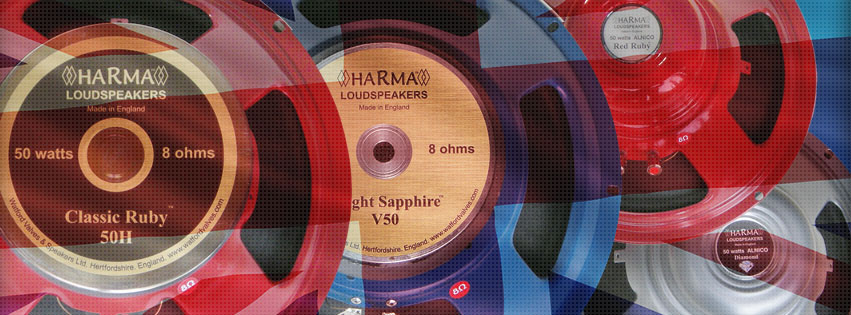 Speakers
Speakers Pedals
Pedals Amp Parts
Amp Parts Cabinets
Cabinets Accessories
Accessories





